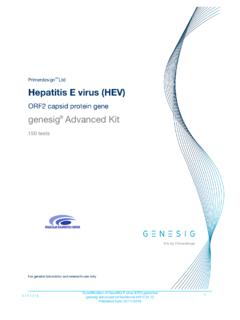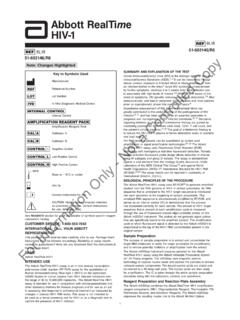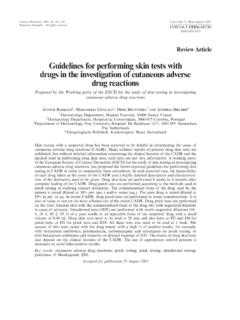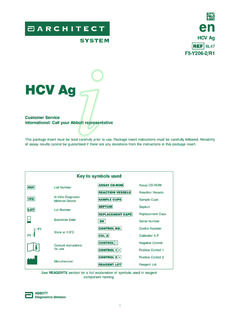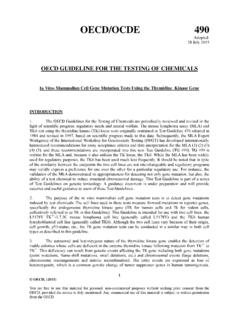Transcription of HbsAg ELISA 96 well plate Kit (TMB) - Ekoweb
1 HbsAg ELISA 96 well plate Kit (TMB) 1(9) Date 07082007 Instruction for use Content 1) Intended Use 2) Summary and test explanation 3) Test description 4) Description of Materials Provided 5) Instructions for use ) Warnings ) Specimen collection and preparation for analysis ) Storage conditions and stability of reagents ) plate washing procedure ) Test procedure ) Calculations of results ) Validity of test runs ) Interpretation of results ) Troubleshooting ) Limitations and interferences ) Flow chart of the test procedure HbsAg ELISA 96 well plate Kit (TMB) 2(9) Date 07082007 1) Intended Use HbsAg ELISA 96- well plate kit (TMB) is an enzyme immunoassay diagnostic kit for in vitro qualitative detection of hepatitis B surface antigen ( HbsAg ) in human serum or plasma (heparin, citrate or EDTA). 2) Summary and test explanation The hepatitis B surface antigen ( HbsAg ) is the first marker that appears in the blood following infection with hepatitis B virus (HBV) some days or weeks before clinical symptoms manifest.
2 It is a lipoprotein polypeptide which constitutes the external envelope of the HB virus. The detection of HbsAg in human serum or plasma indicates an ongoing HBV infection, either acute or chronic. Testing of additional HBV markers is needed to define the specific disease state. HbsAg assays are used not only to diagnose HBV infections but also to monitor the course of the disease and the efficacy of antiviral therapy. HbsAg ELISA (TMB) kit is a fast test for the qualitative detection of the presence of HbsAg in serum or plasma (heparin, citrate or EDTA) specimen. The test utilizes monoclonal and polyclonal (anti-guinea pig) antibodies to selectively detect elevated levels of HbsAg in serum or plasma. Specimens which are non-reactive by HbsAg ELISA test are considered negative for HbsAg . Specimens with positive reaction should be retested in duplicate. In case of a reactive repeat reaction, the specimen should be confirmed for HbsAg reactivity with validated confirmatory reagents.
3 Only confirmed positive specimens are considered to contain HbsAg . 3) Test description HbsAg ELISA (TMB) is a solid-phase enzyme immunoassay ( ELISA = enzyme-linked immuno-sorbent assay) based on the sandwhich principle. The solid phase of the microtiter plate is made of polystyrene wells coated with mouse monoclonal antibodies specific for HbsAg ; whereas guinea pig polyclonal antibody purified by affinity chromatography is used to prepare the anti-HBs-peroxidase (horseradish) conjugate in the liquid-phase. When a serum or plasma specimen containing HbsAg is added to the anti-HBs antibody-coated wells together with the peroxidise conjugated anti-HBs antibody and incubated, an antibody- HbsAg -antibody-peroxidase complex will form on the wells. After washing the microtiter plate to remove unbound material, a solution of TMB substrate is added to the wells and incubated. A colour develops in proportion to the amount of HbsAg boud to Anti-HBs. The peroxidise-TMB reaction is stopped by addition of sulphuric acid.
4 The optical density of developed colour is read with a suitable photometer at 450nm with a selected reference wavelength within 620 to 690nm. The test principle is shown also in the following figure: A) Specimen containing HbsAg : 1. plate well (Anti-HBs) + specimen ( HbsAg ) + Anti-HBs-peroxidase Anti-HBs- HbsAg (Anti-HBs-peroxidase) sandwich complex HbsAg ELISA 96 well plate Kit (TMB) 3(9) Date 07082007 2. Sandwich complex + TMB substrate solution Light blue or blue colour 3. Add sulphuric acid to stop the colour development Read OD at 450nm (reference wavelength 620-690nm) B) Specimen without HbsAg 1. plate well (Anti-HBs) + specimen (no HbsAg ) + Anti-HBs-peroxidase Anti-HBs (on the well ) 2. Anti-HBs (on the well ) + TMB substrate solution Colourless to light blue colour 3. Add sulfuric acid to stop the colour development Read OD at 450nm (reference wavelength 620-690nm) 4) Description of Materials Provided Items Components Description Qt.
5 Per 96 tests (1H) Anti-HBs plate Microtiter plate coated with mouse monoclonal anti-HBs. 1 plate (2H) Anti-HBs Peroxidase Solution Polyclonal anti-HBsHRPO conjugate, diluted in buffer with protein stabilizers. Preservatives: Gentamycin and Thimerosal Dye: phenol red. 1 bottle, 6 ml (3H) CONTROL + HbsAg Positive Control Inactivated human serum positive for HbsAg but non reactive for anti-HCV and anti-HIV1/2, diluted in buffer with protein stabilizers. Preservatives: Gentamycin and Thimerosal 1 bottle, ml (4H) CONTROL - HB Negative Control Serum non-reactive for HBV markers, anti-HCV and anti-HIV1/2, diluted in buffer with protein stabilizers. Preservatives: Gentamycin and Thimerosal 1 bottle, ml (7E) 2N H2SO4 2N sulphuric acid 1 bottle, 10 ml (10E) Conc. Washing Solution D (20X) Concentrated Phosphate buffer with Tween-20 1 bottle, 50 ml (11E) TMB Substrate Solution A of 3,3 ,5,5 -tetramethylbenzidine (TMB) in an organic base.
6 1 bottle, 10 ml (12E) TMB Substrate Solution B Citrate Acid Buffer containing H202 1 bottle, 10 ml Accessories (provided as needed): Adhesive slips Absorbent pads Black cover HbsAg ELISA 96 well plate Kit (TMB) 4(9) Date 07082007 Other required materials, but not provided: 50 ul, 100 ul micropipettes and tips are needed Water bath or incubator with temperature control at +37 C plate washing equipment ELISA Microwell Reader: Dual wavelength 450nm with 620-690nm as reference wavelength, bandwidth 10nm Fully automatic EIA micro- plate analyzer is optional. User should validate the automatic EIA micro- plate analyzer in combination with the kit. Storage condition and stability of the kit and components: Kit/components Storage temp. State Stability HbsAg ELISA -96 (TMB) Kit +2 - +8 C Original Once open 15 months 1 month HbsAg Positive Control +2 - +8 C Original Once open 15 months 1 month HB negative Control +2 - +8 C Original Once open 15 months 1 month Anti-HBs plate +2 - +8 C Original Once open 24 months 1 month Anti-Hbs-HRPO Conjugate Solution +2 - +8 C Original Once open 15 months 1 month Concentrated Washing Solution D (20X) Room temp.
7 Original Once open 24 months 1 month 20 x Diluted Washing solution Room. temp. +2 - +8 C Diluted Diluted 2 days 1 week TMB substrate Solution A +2 - +8 C Original Once open 18 months 1 month TMB substrate Solution B +2 - +8 C Original Once open 18 months 1 month 2N Sulfuric Acid Room temp. Original Once open 24 months 1 month 5) Instructions for use ) Warnings: ) This kit is for professional use only ) This kit is for in vitro diagnosis only ) Bring all kit reagents and samples to room temperature (+20 to +30 C) and mix carefully before use. ) Do not use reagent beyond its expiration date. ) Do not interchange reagents between different lots. ) Do not put pipette in mouth. ) Do not smoke or eat in areas where specimens or reagents are handled. ) All kit components and specimens should be regarded as potential health hazards. It should be used and discarded according to your laboratory`s safety procedures. Such safety procedures probably include the wearing of protective gloves and avoiding the use of aerosols.
8 HbsAg ELISA 96 well plate Kit (TMB) 5(9) Date 07082007 ) Potential infectious specimens and non-acid containing spills or leakages should be wiped up thoroughly with 5% sodium hypochlorite or treated in accordance with your practice for potential bio-hazard control. ) Prior to disposing used specimens and kit reagents as general waste; it should be treated in accordance with the local practice of potential bio-hazardous waste or treated as follows: Both liquid and solid waste should be autoclaved at +121 C for at least 30 minutes. Solid waste can also be incinerated. Non-acidic liquid waste can be treated with sodium hypochlorite diluted to a final concentration of 1 %. Acidic liquid wastes must be neutralized before treatment with sodium hypochlorite as mentioned above and should stand for 30 minutes to obtain effective disinfection. ) 2N Sulfuric Acid is an irritant to skin, eyes, respiratory tract and mucous membranes. Avoid contact of the 2N sulfuric acid with skin and mucous membranes.
9 In case of contact, flush immediately with abundant amounts of water. In case of inhalation, find fresh air and seek medical attention in case of pain. ) TMB substrate solution A contains organic solvent, which is flammable. TMB substrate solution A contains dimethyl sulfoxide, an irritant to skin and mucous membranes. ) Although all human sourced material are tests non reactive for Anti-HCV and Anti-HIV, and inactivated at +56 C for one hour, the reagent shall be handled as potential infectious material. ) Specimen collection and preparation for analysis ) No special preparation of the patient is required prior to blood collection. Blood should be collected by approval medical techniques. ) Either serum or plasma specimens can be used with this test kit. Whole blood specimen should be separated as soon as possible in order to avoid hemolysis. Any particulates ( fibrin clots, erythrocytes) contained in the specimen should be removed prior to use. ) Specimens must be stored at +2 to +8 C and avoid heat-inactivation to minimize deterioration.
10 For long-term storage, they must be frozen below -20 C. Storage in self-defrosting freezer is not recommended. ) Frozen specimens must be thoroughly thawed and mixed homogenously before test. ) Avoid multiple freeze-thaw procedures. Warning: 1. Specimen must not contain any compounds of AZIDE, which inhibits the peroxidise activity. 2. Incompletely coagulated sera and microbial-contaminated specimens should not be used. ) Storage conditions and stability of reagents ) The kit must be stored at +2 to +8 C. Do not freeze. ) Strips of the plate should be used within one month after opening the original aluminium foil bag. The unused strips should be kept in the aluminium foil bag and taped tightly. ) Return reagents to +2 to +8 C immediately after use. ) Washing Solution D (20x) Concentrate can be stored at room temperature to avoid crystallization, because the kits are stored at +2 to +8 C. If crystals have been precipitated before use, warm up the solution in 37 C water bath till the crystals dissolve.
